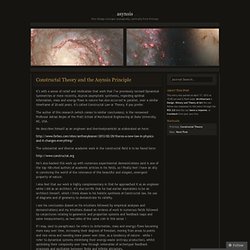

Emergence. In philosophy, systems theory, science, and art, emergence is a process whereby larger entities, patterns, and regularities arise through interactions among smaller or simpler entities that themselves do not exhibit such properties.

Emergence is central in theories of integrative levels and of complex systems. For instance, the phenomenon life as studied in biology is commonly perceived as an emergent property of interacting molecules as studied in chemistry, whose phenomena reflect interactions among elementary particles, modeled in particle physics, that at such higher mass—via substantial conglomeration—exhibit motion as modeled in gravitational physics. Constructal Theory and the Asynsis Principle. It’s with a sense of relief and vindication that work that I’ve previously termed Dynamical Symmetries or more recently, Asynsis (asymptotic synthesis), regarding optimal information, mass and energy flows in nature has also occurred in parallel, over a similar timeframe of 20-odd years.

It’s called Constructal Law or Theory, if you prefer. The author of this research (which comes to similar conclusions), is the renowned Professor Adrian Bejan of the Pratt School of Mechanical Engineering at Duke University, NC, USA. He describes himself as an engineer and thermodynamicist as elaborated on here: The substantial and diverse academic work in the constructal field is to be found here: He’s also backed this work up with numerous experimental demonstrations (and is one of the top 100-cited authors of academic articles in his field), so I finally feel I have an ally in convincing the world of the relevance of this beautiful and elegant, emergent property of nature. L-system. L-system trees form realistic models of natural patterns Origins[edit] 'Weeds', generated using an L-system in 3D.
As a biologist, Lindenmayer worked with yeast and filamentous fungi and studied the growth patterns of various types of algae, such as the blue/green bacteria Anabaena catenula. Originally the L-systems were devised to provide a formal description of the development of such simple multicellular organisms, and to illustrate the neighbourhood relationships between plant cells. Issw-1998-060-066.